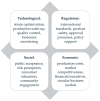Harnessing Microbial Power for a Sustainable Future Food System
- PMID: 41011548
- PMCID: PMC12472289
- DOI: 10.3390/microorganisms13092217
Harnessing Microbial Power for a Sustainable Future Food System
Abstract
Microorganisms are transforming the way we address sustainability across agriculture, food production, waste remediation, bioenergy, and industrial bioprocessing, offering novel solutions for the food systems of tomorrow. This systematic review examines literature from the last twenty years in order to identify key advances, challenges, and future directions in harnessing microbial systems for sustainable applications, especially those underpinning a resilient future food system. The selected documents allowed a mapping of the most important trends: innovations based on metabolic engineering and omics, the use of integrated biorefineries, and digital monitoring platforms are emerging as catalysts for the transition, while high scaling costs, regulatory challenges, and low public acceptance continue to limit large-scale implementation. The analysis highlights both the major advantages (reducing ecological impact, valorizing waste, diversifying food sources) and the current limits of these technologies, proposing a multi-stakeholder roadmap to accelerate the transition to a circular bioeconomy and a low-carbon and climate-resilient food system.
Keywords: biofertilizers; biofuels; circular bioeconomy; food security; microbial biotechnology; sustainable food systems.
Conflict of interest statement
The authors declare no conflicts of interest.
Figures












References
-
- Puma M.J., Bose S., Chon S.Y., Cook B.I. Assessing the Evolving Fragility of the Global Food System. Environ. Res. Lett. 2015;10:024007. doi: 10.1088/1748-9326/10/2/024007. - DOI
-
- Calo A., McKee A., Perrin C., Gasselin P., McGreevy S., Sippel S.R., Desmarais A.A., Shields K., Baysse-Lainé A., Magnan A., et al. Achieving Food System Resilience Requires Challenging Dominant Land Property Regimes. Front. Sustain. Food Syst. 2021;5:683544. doi: 10.3389/fsufs.2021.683544. - DOI
-
- Linder T. Making the Case for Edible Microorganisms as an Integral Part of a More Sustainable and Resilient Food Production System. Food Secur. 2019;11:265–278. doi: 10.1007/s12571-019-00912-3. - DOI
Publication types
Grants and funding
LinkOut - more resources
Full Text Sources

